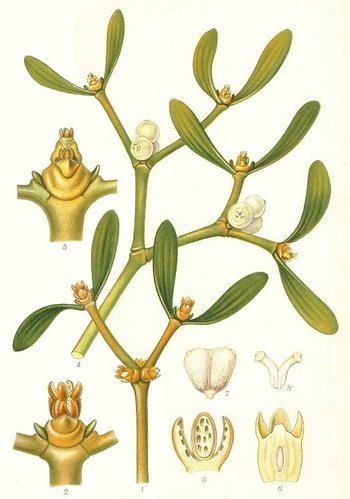Mistletoe Bela – VISCUM album L.
Family Loranthaceae – Strapiformaceae
Mistletoe - description of the plant
Evergreen semi-parasitic small shrub, prikrepljajushhijsja on the branches of the tree-master, penetrating bark wood special, root-like formations - haustoria, sucking nutrients. The stem is highly dichotomously branched. Leaves are opposite, narrowly elliptical or spatulate, sessile, blunt, tselnokraynie. Flowers bisexual, with a simple yellowish-green 3-4-partite perianth, located along 3 (5-6) on the branches of young shoots. Fruit - round white (pale yellowish) sticky berry with 1-2 (3-4) black seeds. Blooms in March-April.
Spread. Grows on various genera of gymnosperms and angiosperms (mostly rosaceae) woody plants in foothill and mountain areas. It is found throughout Europe.
Raw materials. Summer-collected leaves with twigs or just leaves, dried at ordinary temperatures or in dryers, at a temperature not exceeding 45°C, the resulting material is yellowish-green in color with a slightly tart taste, without much aroma.

Content of active substances in mistletoe
The chemical composition of mistletoe is complex and still poorly understood.. Viscotoxin isolated, which is a mixture of various peptides. Also contains choline, acetylcholine, waxes, Authentication, resin, oleanoic acid, etc..
The main medicinal effect of mistletoe
Gipotenzivnoe.
Experimental and clinical data on the therapeutic effects of mistletoe
Mistletoe has long been used in medicinal practice., and its effects have been studied by many researchers. But, Despite this, There are still conflicting data and opinions in the literature regarding its effectiveness in clinical settings. Among these data there are both enthusiastic opinions, and skeptical doubts. All this indicates the need for further research, to give an objective scientific assessment of the effects, which have biologically active substances contained in it.
Despite this, most of the data obtained indicate, that mistletoe affects a number of organs and systems of the body.
The substances contained in mistletoe have a suppressive effect on the central nervous system., prevent or reduce seizures, inhibit the cardiovascular center, reduce central excitability, measured chronaximetrically.
Mistletoe preparations, mainly due to their suppressive effect on the centers of the medulla oblongata, reduce blood pressure. This effect is definitely facilitated by the direct vasodilatory effect in a number of areas - the lower extremities, liver.
According to various sources, macerate has the highest hypotensive activity., made from leaves, collected in January, mistletoe, growing on willows.
Established, that under experimental conditions, an alcoholic infusion of mistletoe has a positive inotropic effect on the heart.
Newer data suggests, that mistletoe preparations have an inhibitory effect on cell division and DNA synthesis.
The main indication for the use of various preparations from mistletoe — hypertension in the initial phases and various etiopathogenetic characteristics: hypertension stages I and II, hypertension during menopause, hypertension after traumatic brain injury.
Results from targeted clinical studies show, what (according to most authors) almost 50% cases on patients treated with mistletoe extract or macerate there was an effect, expressed by a decrease in blood pressure in some patients, reduction of headaches or cessation of pain and improved sleep, restoration of good health, etc.. d.
There are also publications, in which it is reported, that when treating patients with hypertension with mistletoe preparations, there were no cases of antihypertensive effect.
On the other hand, reports of the beneficial effects of mistletoe on patients with hypertension indicate, that's almost 50% patients experienced undesirable side effects: dizziness, loss of appetite, bad feeling.
Methods of using mistletoe in medicine
In phytotherapeutic practice, white mistletoe is used in the form of various herbal preparations.: insisted, decoction, liquid extract, the macerata, alcohol infusion.
Pour a teaspoon of raw material into a glass of water and leave in a cool place for several days.. Then strain and take a tablespoon 2-3 times a day.
Mistletoe is often prescribed in combination with other cardiovascular and neutrotropic agents of plant origin., as, eg,, with hawthorn, valerian officinalis, horsetail.
